The material a kayak is made of affects how it looks, performs and holds up over time. Even beyond the important considerations of performance, aesthetics, cost, durability, weight, and ease of transportation and storage, the material a kayak is made from can also influence the pleasure you get from paddling it. Knowing the advantages and disadvantages of each type of material will help ensure you choose a kayak material that best suits your needs and preferences.
So what are kayaks made of? In this article, we’ll go over the main materials used to construct hard-shell and inflatable kayaks, in addition to the various manufacturing processes. You’ll learn the pros and cons of different kayak material types, so you can decide which kayak material is perfect for your needs. Arm yourself with this knowledge before you step into a kayak shop in search of your first—or next—kayak!
Kayak materials pros and cons
Hard-shell kayak materials
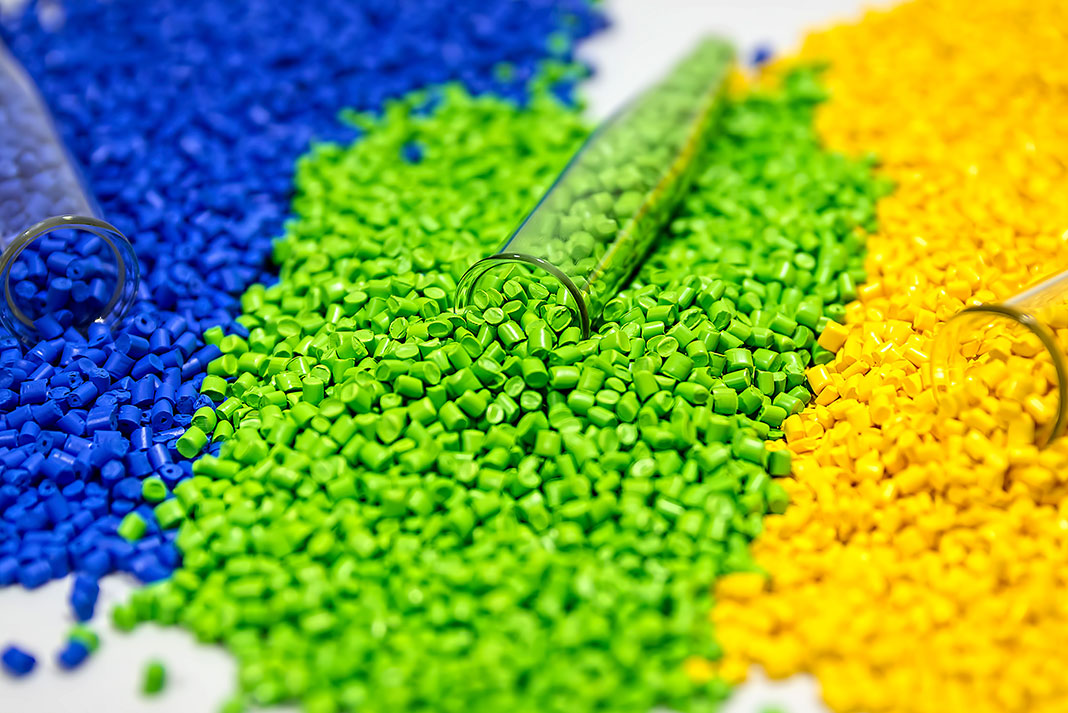
Rotomolded polyethylene kayaks
Polyethylene is a resilient plastic that’s used for everything from automobile body panels to food storage containers to traffic cones. As this list hints at, it is an exceptionally versatile and durable material. Polyethylene is also the most widely used and inexpensive plastic kayak material. These so-called “Tupperware kayaks” will last for many years with minimal care.
The first rotomolded polyethylene kayaks were introduced in the 1970s. To make a hull, plastic pellets are poured into a hollow metal mold that is then heated and rotated in a massive oven to distribute the now-molten plastic throughout the mold.
After it has cooled, the mold is removed to reveal a perfectly cast, single-piece kayak that requires only light hand finishing—such as outfitting the cockpit and hatches, and installing a skeg or rudder—to be ready. The speed and simplicity of the manufacturing process keeps the cost of polyethylene boats lower than other kayak materials.
If the abuse your kayak may suffer includes descending rocky or shallow rivers, seal launching from cobble beaches, dragging up sand beaches and indelicate rooftop or trailer transportation, then polyethylene may be perfect for you. Most whitewater kayaks, fishing kayaks and recreational kayaks exploit the exceptional durability of rotomolded polyethylene. It’s also a popular kayak material for entry-level touring and sea kayaks, as well as those designed for surfing and ocean play.
Pros
- The most inexpensive, widely available hard-shell kayak material
- Unparalleled versatility and design options
- Impact-resistant, nearly indestructible construction is suitable for whitewater, rocky shorelines and years of maintenance-free use
- High-quality, rotomolded kayaks offer great performance-to-price value
Cons
- Heavier than other kayak materials
- Polyethylene is degraded by UV. To ensure greater longevity, treat your plastic kayak with 303 Protectant or a similar UV-blocking spray or wax
- Speed-sapping hull weakening and warping (called oil-canning) can occur in older, sun-damaged plastic hulls (or even new kayaks strapped too tightly to a roof rack on a warm day)
- Abrasions from rocks and barnacles leave fuzzy, curly, tufts of plastic, increasing drag and decreasing hull speed
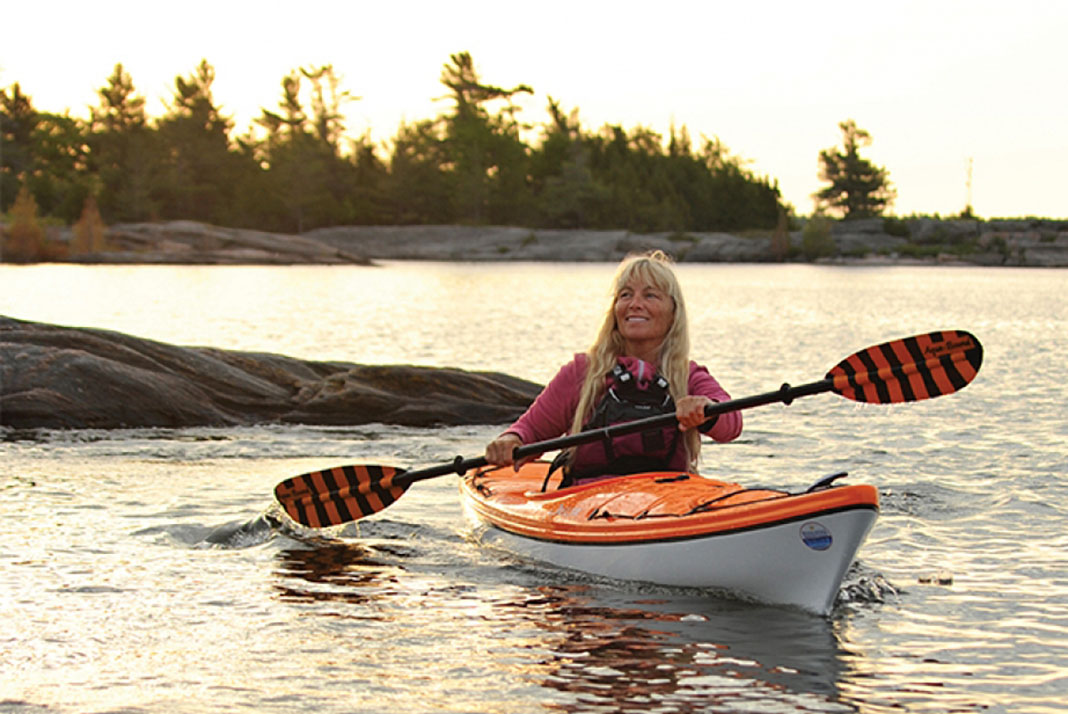
Thermoform kayaks
Thermoform kayaks offer a superb, mid-range compromise between polyethylene and composite kayaks.
Thermoformed kayaks use an advanced plastic laminate construction to combine the affordability and durability of plastic with the lighter weight, shiny aesthetics and sleek feel of composites. Because manufacturing is significantly less labour-intensive than composite construction, thermoformed kayaks are priced only marginally above rotomolded.
The thermoforming process uses a vacuum to wrap heated plastic sheets over the kayak molds, allowing designers to produce finer lines and more complex shapes while using less material than rotomolding. Less material is not only more efficient, it also results in a lighter kayak. The deck and hull are thermoformed separately, then trimmed, detailed and joined at the sheerline with adhesive and tape.
The plastic sheet material used to make thermoformed kayaks fuses an impact-resistant ABS plastic base layer to one or more thin outer layers of glossy acrylic. It’s this shiny, scratch- and UV-resistant acrylic cap that gives thermoform kayaks their head-turning finish.
Whether you are in the market for a premium rec kayak, lighter weight fishing kayak or expedition-ready touring kayak, there’s a thermoformed option to suit your needs and budget.
Pros
- More scratch-resistant and lighter than rotomolded polyethylene kayaks
- Acrylic outer layer provides a glossy finish that looks like fancy composite kayaks
- Attractive price-to-performance ratio
- Easier to repair than polyethylene and can be recycled at end-of-life
Cons
- UV-exposed ABS base layer will degrade over time, even with proper maintenance. Store your kayak indoors, if possible, or upside-down on an outdoor rack
- Be cautious in cold climates. At below-freezing temperatures, hard impacts can shatter thermoformed plastic laminate
- Many manufacturers don’t offer thermoformed kayaks—this material might not be an option if you have your heart set on a specific design
Composite kayaks
Composite kayaks include those made from resin-impregnated laminates of fiberglass, aramid fibers, carbon fiber or a blending of these and other high-tech synthetic fabrics. Some manufacturers also add foam or honeycomb cores between the fabric layers for extra rigidity.

The primary differences between these various composite kayak materials are weight and cost, with the lightest materials being the most expensive. If a kayak is listed as “composite” construction, be sure to clarify which material it’s made of:
- Fiberglass is the original, tried-and-true composite material. The excellent strength-to-weight ratio and affordable cost of fiberglass makes it the most popular choice for premium sea kayaks
- Aramid fiber—synonymous with the brand name Kevlar—offers strength and rigidity similar to fiberglass, but is lighter and more expensive. Aramid and fiberglass-Aramid blends are more common in weight-saving light touring kayaks, expedition kayaks and surf skis
- Carbon fiber is the lightest (and most costly) composite kayak material. While it is typically used for elite sport and racing kayaks, ultralight carbon rec and touring kayaks are also available
Whichever fabrics are being used, all composite kayaks take shape in a similar way. Gelcoat is sprayed into separate deck and hull molds followed by hand-laid layers of cloth bonded by resin. Vacuum bag technology allows the resin to be injected and distributed more quickly and evenly than hand-pressing the layers, but some composite expedition kayaks are still built entirely by hand. Fiberglass tape and resin join the deck and the hull together.
Composite kayaks are beautiful to look at and efficient to paddle. Composite construction allows for sleeker lines than rotomolding or thermoforming, and composites are stiffer than plastics, making them faster and more responsive on the water.
Composites, especially premium lay-ups like carbon fiber and aramid, are also lighter on your shoulder—but not on your wallet. These are the most expensive hard-shell kayaks. Still, the longevity of composite kayak materials means that a one-time investment can last your whole paddling career.
Pros
- Lightweight construction with a superb strength-to-weight ratio
- Performance, responsiveness and efficiency are superior to plastic kayaks
- Scratches, spider cracks and even punctures can be repaired with minimal tools and a YouTube education
- Composites are UV-resistant and abrasions leave smooth scratches, which don’t impair hull speed
Cons
- Most expensive hard-shell kayak material
- The stiffness of composites makes them susceptible to severe cracks and punctures from direct hits. Avoid surfing into rocks or banging down bony rivers
- Used kayak shoppers are likely to encounter retro teal-and-purple color schemes and out-dated outfitting, since well-cared-for composite kayaks can still perform decades after their prime
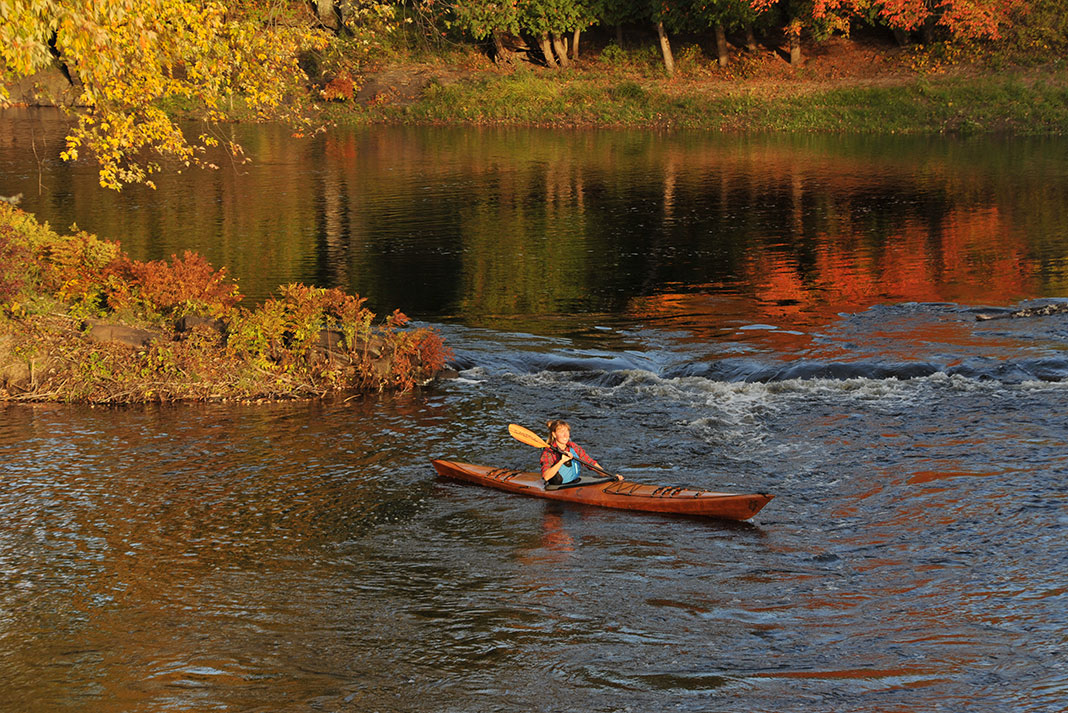
Wooden kayaks
Most wooden kayaks are the products of do-it-yourself home builders. These are not kayaks that you will find on the shelves of big box retailers or even your local paddling shop.
Fortunately, you don’t need to be a master woodworker to build your own wooden kayak.
There are two common construction styles that are available as plans or complete kits:
- Stitch-and-glue wooden kayaks are faster to assemble and don’t require any previous woodworking experience. Even first-time builders can achieve showroom results by stitching pre-cut pieces of plywood together with wire, and then gluing the seams with epoxy resin. Once assembled, the exposed wire is trimmed and the wooden kayak is typically covered in protective layers of fiberglass and resin, and finished with UV-resistant varnish.
- Strip-built wooden kayaks offer unlimited design freedom but demand more patience from DIY builders. Previous experience working with wood is helpful, since this construction method involves binding many thin wood strips together around temporary frames.
Nothing beats the natural beauty and limitless creative possibilities of wood. Even better, it’s among the lightest kayak materials available and wooden kayaks perform with the same speed, efficiency and durability as advanced composite kayaks.
The low cost for a DIY wooden kayak is equally attractive. Build it yourself and you’ll have a composite-quality boat at a less-than-polyethylene price.
Pros
- Wooden kayaks are significantly lighter than fiberglass composites, with hull strength comparable to Kevlar or carbon composite kayaks
- Kayaks made of wood are unique, robust and look amazing
- Composite-quality kayaks at a much lower price for DIY builders
- The satisfaction of paddling a kayak you built with your own hands
Cons
- Building a wooden kayak is time-intensive. Plan on upwards of 100 hours for your first stich-and-glue touring kayak, longer for strip-built designs
- Not handy with clamps and epoxy? If you get someone else to build your wooden kayak for you it can cost even more than a composite boat
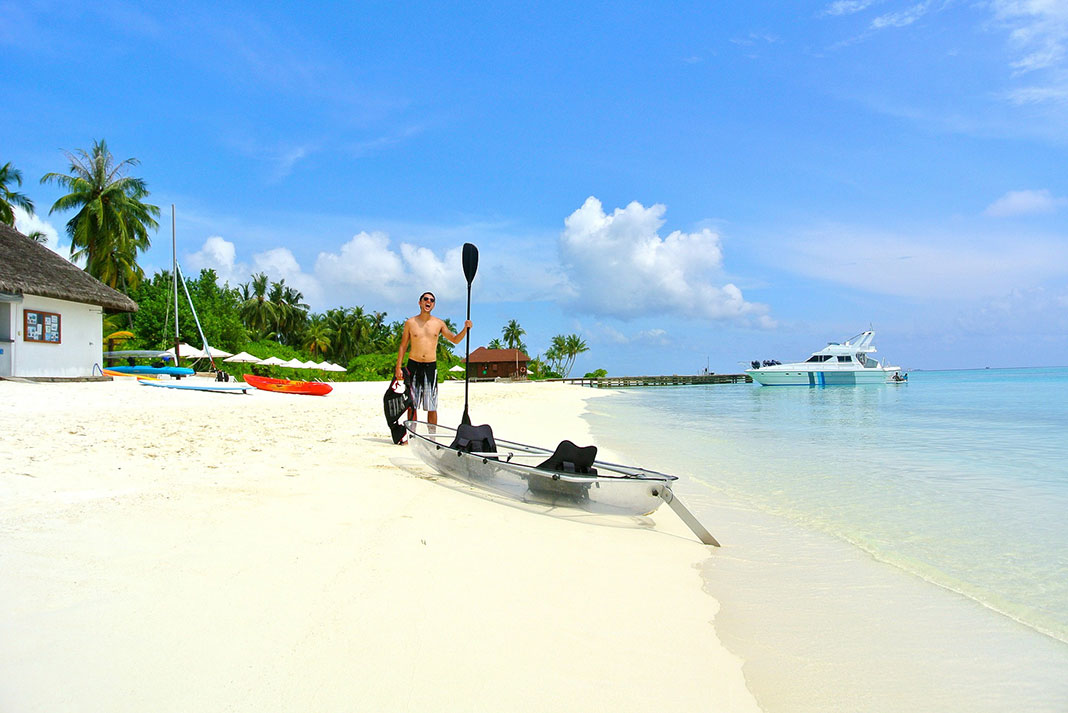
Polycarbonate kayaks
Since the first see-through kayaks appeared on the water (and on Instagram), transparent kayaks have become a staple on ocean and river tours from Bali to Belize. But they are also trending on local waterways, offering recreational paddlers a glimpse beneath their hulls.
So what are clear kayaks made of anyway? See-through hulls and decks are made from sheets of polycarbonate—widely known by the trade name, Lexan. Aside from clear kayaks, polycarbonate is used in everything from vehicle headlamps and television screens to bulletproof glass and fighter jet canopies.
Both polycarbonate and acrylic are examples of thermoplastics—meaning they can be formed by heat into complex shapes without cracking or breaking. Clear kayaks made of polycarbonate are manufactured using vacuum thermoforming. With around 30 times the impact resistance of acrylic, polycarbonate makes for an even more robust hull than standard thermoformed kayaks.
Most clear kayaks feature a high-sided, transparent hull and open sit-on-top design, similar to a canoe. Many also incorporate a simple aluminum frame to add rigidity to the hull. Because they usually lack a deck to shed water or bulkheads for floatation, clear kayaks are best suited to recreational touring on calm waters.
Pros
- Clear kayak material allows paddlers to enjoy an out-of-this-world view below the water’s surface
- Highly impact-resistant and relatively lightweight
Cons
- Designs are limited to open-topped recreational kayak models
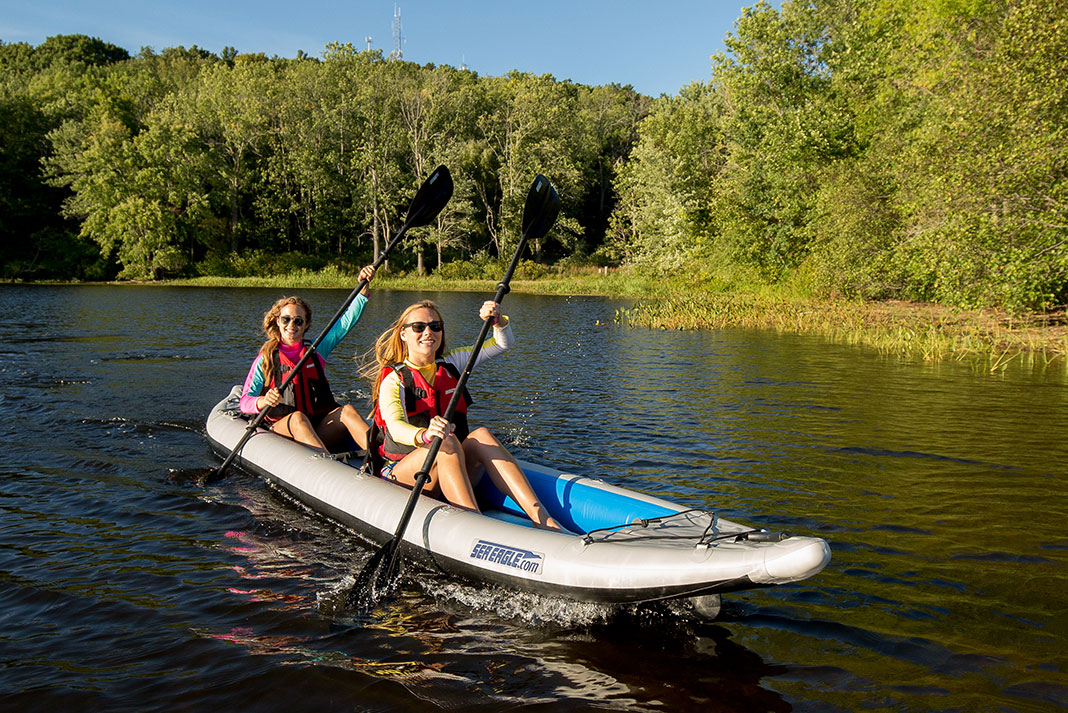
Folding and inflatable kayak materials
Inflatable kayaks
Inflatable kayaks offer users unparalleled portability and ease of storage. These kayaks are made from rubber-like materials that allow them to be rolled into a duffle bag or backpack when not in use—making them a great option for those who don’t have the space to store a full-size kayak or a car to transport it.
Inflatable kayaks vary widely in terms of design complexity and sophistication. High-end inflatables employ drop-stitch construction, baffles and fused air chambers to achieve greater rigidity, puncture-resistance and more efficient hull shapes. The most inexpensive inflatable kayaks are little more than simple tubes shaped to resemble a canoe or kayak.
Choosing the best material for inflatable kayaks is a matter of balancing strength, weight, cost and environmental sustainability. The three most common materials are:
- PVC, or polyvinyl chloride (also known simply as vinyl), is the most widely used inflatable kayak material. PVC is inexpensive, relatively lightweight, and can be bonded to nylon or other materials to make it more tear-resistant. However, PVC is prone to UV damage and the toxic chemicals released throughout its lifecycle make PVC the most environmentally damaging of all plastics.
- Nitrylon is a more eco-friendly alternative that also has better longevity than PVC. This lamination of synthetic nitrile rubber and 1200-denier polyester fabric is relatively heavy, but its superior abrasion- and puncture-resistance makes it suitable for use in the floors and side tubes of inflatables.
- Polyurethane, also known as urethane or TPU (thermoplastic polyurethane), is a rugged, high-performance material that straddles the gap between plastics and synthetic rubbers. Polyurethane offers excellent strength-to-weight, flexibility, UV stability and resistance to mildew, abrasion and extreme temperatures. Polyurethane also gets high marks for environmental sustainability—no toxic chemicals are used during its production, and urethane boats can be recycled at end-of-life.
From bombproof, self-bailing inflatable kayaks for extreme whitewater paddling, to feature-rich inflatables with covered decks and gear storage for touring, the best blow-up boats will cost you about the same as a rotomolded or thermoformed hard-shell kayak.
At the opposite end of the spectrum, the inflatables available at big box retailers are simple, inexpensive and suitable only for the most sheltered waters.
Pros
- Kayaks made from inflatable materials can be rolled or folded for storage or transport
- Many inflatables include patch kits for easy repairs to small punctures
- Lightweight and inexpensive options abound
- High-quality inflatable kayaks designed for rivers are more stable and rival the durability of plastic kayaks—perfect for introducing novices to whitewater
Cons
- Inflatable kayaks are susceptible to punctures and damage from UV exposure
- PVC is an environmentally harmful material
- Inflatables require careful storage to avoid developing mold and mildew
- The lifespan of most inflatable kayaks is significantly shorter than hard-shell kayaks
Folding kayaks
Folding kayaks offer easy portability and storage similar to inflatable kayaks, with the added advantage of performance and designs closer to that of hard-shell kayaks.
There are two general types of folding kayak construction. If you are wondering what folding kayaks are made of, the answer is it depends on the style of the kayak:
- Skin-on-frame folding kayaks use an aluminum or wooden frame that folds or disassembles for storage. A flexible, watertight “skin” of polyurethane, synthetic rubber and/or nylon is then stretched over this skeleton to form the hull and deck of the kayak.
- Single-sheet collapsible folding kayaks are manufactured from twin-layer polypropylene plastic sheeting that is creased to allow easy folding and interlocking.
Folding kayaks do not have built-in bulkheads, so air bags or another form of buoyancy should be used in these boats when touring on open or moving water. Some manufacturers also offer hybrid folding-inflatable kayaks, incorporating both skin-on-frame construction and inflatable tubes for added stability and floatation.
Pros
- Folding kayaks offer easy portability and storage
- Premium folding kayaks rival plastic and composite kayaks for sleekness, performance and durability
- Many folding kayaks include patch kits for repairing minor tears
- Superior gear storage compared to inflatable kayaks
Cons
- Skin-on-frame folding kayaks require more maintenance
- Improperly stored folding kayaks are prone to mold and mildew
- Cost varies widely—from about the same as rotomolded, to more than composite
- Assembly and disassembly can be more challenging than inflatable kayaks

Best kayak material
In this article, we have looked at a wide variety of kayak material types. Like most beginner paddlers, you may be wondering at this point: what is the best material for a kayak?
Well, there’s no definitive answer to that question. The best material for a kayak really depends on where, when, how (and how often) you’ll be using it, and what you are looking for from your paddling experience. And, of course, how much you have to spend.
Each kayak material has its own distinctive qualities that either enhance—or detract from—your kayaking experience.
Consider the advantages and disadvantages of each material, then decide what size kayak you need and what is an acceptable weight. Finally, set a budget.
My advice is to test paddle as many kayaks as you can before you buy. You may decide that the heavier weight of a rotomolded polyethylene kayak is more than compensated for by its worry-free durability, huge variety of design styles and economical price tag.
Alternatively, you may demo a thermoformed kayak and realize that you value the light weight, brilliant finish and sleek performance enough to justify spending a bit more.
If you’ve been paddling borrowed kayaks for some time, you may already have a sense of what you like and have been saving up for a truly special investment in the activity you love. In this case, the best kayak material may be a top-of-the-line Kevlar composite kayak in a stunning custom color palette!
Materials for different parts of a kayak
Kayak deck materials
The deck of a hard-shell kayak may be molded as part of a single piece that includes the hull, or made separately and then attached to the hull. Common kayak deck materials include polyethylene, thermoformed ABS-acrylic, fiberglass and aramid (Kevlar).
Kayak hull materials
Kayak hulls are most commonly made of polyethylene, thermoformed ABS-acrylic, fiberglass or Aramid (Kevlar).
Kayak hatch gasket materials
The dryness, ease of use and durability of a kayak’s hatch gaskets are important aspects to consider before a purchase. Different manufacturers have different solutions when it comes to the perfect kayak hatch material. Natural, all-rubber hatches are a popular, tried-and-true option among sea kayakers, especially on European, British and Greenland-style kayaks. Thermoformed plastic hatches have integrated rubber gaskets to create a watertight seal. Some composite touring kayaks feature two-part hatches, with a fiberglass hatch cover secured overtop of a waterproof neoprene gasket.
Kayak bulkhead material
Composite and thermoformed kayak bulkheads are typically manufactured from the same or similar material as the kayak’s hull and deck. For example, fiberglass or thermoformed plastic. Rotomolded kayak bulkheads are either made from polyethylene or closed-cell foam, depending on the manufacturer. These bulkheads are often bonded to the interior of the hull and deck with a polyurethane sealant.
Kayak skin material
Folding kayaks use a variety of kayak skin materials for the deck and hull. Common materials for the deck include polyurethane, nylon or waterproof canvas. The skin material for the hull may be a rugged polyurethane or Hypalon (synthetic rubber).
Skin on frame kayak materials
Traditional skin-on-frame kayaks date back thousands of years to the earliest Inuit designs, which used sewn seal skins stretched over a driftwood and whale bone frame. Today, modern skin-on-frame kayaks preserve the sleek beauty and efficiency of those traditional designs, recreated in waterproof canvas over a wooden frame.
This article was first published in the Early Summer 2022 issue of Paddling Magazine. Subscribe to Paddling Magazine’s print and digital editions, or browse the archives.
I spy with my little eye, a lot of plastic kayaks. | Feature photo: Michael Connor





